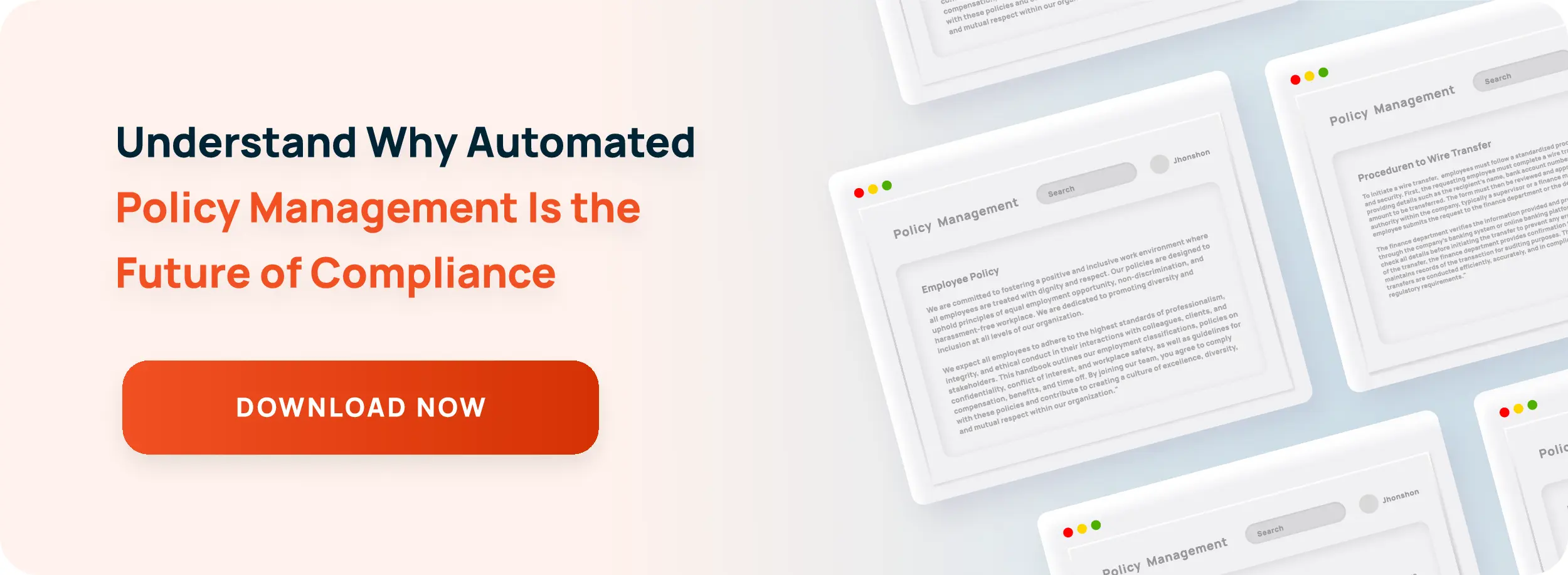5 Steps to Ensure Compliance with Policies and Procedures
Compliance with Policies and Procedures
Establishing effective policies and procedures does not begin and end with regulations. It takes the right amount of collaboration, the right types of distributive mediums, and the right methods to measure understanding. All of these things take an enormous amount of time and energy, but automating them with a software solution can increase efficiency, and ensure compliance with your policies and procedures.
Here are 5 steps to ensure compliance, and what software features to look for to choose the best possible solution.
- Meet with divisional leaders to ensure the policies and procedures being created are feasible for individual departments.
- Determine the best format of policies for your different audiences.
- Make Policies and Procedures easily accessible to your employees.
- Set deadlines for each policy and procedure to be acknowledged.
- Determine the best way to measure the understanding your employees have of policies and procedures.
1. Get Leadership Buy In
The first step to ensuring compliance begins with involving the leaders of each section of the organization. Policies are often created by someone within an organization that does not have a comprehensive understanding of the daily tasks within each department. Involving others, even if just for a 30 minute interview surrounding a policy, ensures that the new policies:
- Are not misunderstood
- Use the correct terminology
- Make sense to the employee
2. Determine the best format of policies for your audience
Different departments contain different personalities, schedules, and daily experiences. To ensure compliance with policies and procedures, make sure that you deliver them to your employees through vessels they are comfortable with. A benefit to meeting with your divisional leaders is that you can leverage more information from them, including how the policies will be best received. Examples of different vessel requirements include situations where employees do not access computers during the work day but may have a company smartphone, making them better candidates for a video presentation of their policies and procedures.
3. Make Policies and Procedures easily accessible to your employees
Structure your folders by:
- Department
- Type of Policy (EX: Management “ Fire Drill Procedure)
And give links to these shared drives to the appropriate managers.
4. Set deadlines for each policy and procedure to be acknowledged
Setting deadlines for acknowledgment does not just mean establishing an Outlook Calendar reminder on their effective date.
Once the policies and procedures have been created and are accessible, set up weekly meetings with all managers to ensure they have a successful plan in place to ensure employee compliance and understanding.
If you send out surveys to each employee, send scheduled email reminders for them to guarantee they have received the policies and procedures, and know the deadlines.
Include a contact number and email address within their reminders in case they have questions.
To manage this process without slowing down your email servers, consider using a software solution for policies and procedures. Solutions such as ConvergePoint are built into SharePoint, stay behind your firewall, and access your Active Directory, so you don’t have to worry about working an entirely new program into your company.
5. Determine the best way to measure understanding
Each policy and procedure is an individual and should be treated as such. Standardized œI accept responses are okay for some standard policies, but ensuring compliance with procedures should go a step further to guarantee to understand.
Depending on the task or field, taking quizzes, scheduling practice runs, or a combination of both can dramatically increase your employee compliance with policies and procedures.
5 Steps: Automate Policy and Procedures Management
- Meet with divisional leaders to ensure the policies and procedures are feasible.
Look for a program that allows custom certifications for your employees. Being able to create a custom quiz gives you the power to control the content your employees remember most. - Determine the best format of policies for your audience.
Software programs that allow multiple formats to be uploaded, such as Microsoft Office Word and PowerPoint, mp3 and mp4’s should be considered for optimal effectiveness. - Make Policies and Procedures easily accessible to your employees.
Ensure the program you use allows flexibility with folders and organization. Finding a program with permission controls will help reduce clutter for your end users. - Set deadlines for each policy and procedure to be acknowledged.
Finding a program that sends alerts to the right people should be a main priority. Notifications should include task alerts, over-due notifications, and renewal notices to name a few. - Determine the best way to measure the understanding your employees have of policies and procedures.
Automating this step can increase efficiency. Programs that send automatic alerts, allow a central area for discussions, and provide workflows can save time during the creation of policies, as well as during the audit process.
